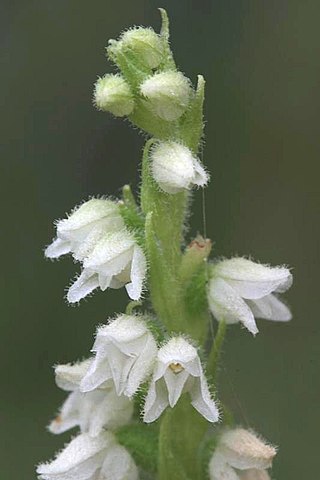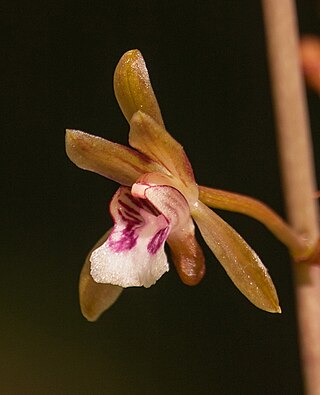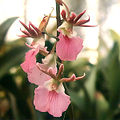
Orchids are plants that belong to the family Orchidaceae, a diverse and widespread group of flowering plants with blooms that are often colourful and fragrant. Orchids are cosmopolitan plants that are found in almost every habitat on Earth except glaciers. The world's richest diversity of orchid genera and species is found in the tropics.

The Royal Horticultural Society (RHS), founded in 1804 as the Horticultural Society of London, is the UK's leading gardening charity.

Ansellia is considered a monotypic genus of orchid, with only one species, Ansellia africana, commonly known as African ansellia or leopard orchid, however, it may in fact be a complex group of species which share common floral structure and growth habit.

Oeceoclades decaryana is a terrestrial orchid species of the genus Oeceoclades that is native throughout southern and southeastern Africa. It can be found growing in Kenya, Mozambique, Zimbabwe, Madagascar, and KwaZulu-Natal in South Africa. It was first described by the French botanist Joseph Marie Henry Alfred Perrier de la Bâthie in 1935 as a species in the genus Eulophia. He later transferred this species to the genus Lissochilus in 1941, followed by another transfer to the genus Eulophidium in 1957 by the English botanist V.S. Summerhayes in 1957. When Leslie Andrew Garay and Peter Taylor revised the genus Oeceoclades in 1976, they transferred this species to the expanded Oeceoclades.

Osmunda regalis, or royal fern, is a species of deciduous fern, native to Europe, Africa and Asia, growing in woodland bogs and on the banks of streams. The species is sometimes known as flowering fern due to the appearance of its fertile fronds.

Encyclia is a genus of orchids. The genus name comes from Greek enkykleomai, referring to the lateral lobes of the lip which encircle the column. It is abbreviated as E. in the horticultural trade.

Eulophia andamanensis is an orchid found to occur among the Andaman and Nicobar group of Islands (off the east coast of India and also in the north-western tip of Langkawi island in Malaysia.The occurrence of this ground orchid in Andaman Islands is restricted to some isolated pockets of certain islands and rare. Living collections of this taxon from the Andaman Islands is under ex situ conservation outside the islands at the Field Gene Bank of Jawaharlal Nehru Tropical Botanic Garden and Research Institute, Trivandrum, India. It is a pre-tsunami accession.

Chaenomeles speciosa, the flowering quince, Chinese quince or Japanese quince, is a thorny deciduous or semi-evergreen shrub native to eastern Asia. It is taller than another commonly cultivated species, C. japonica, usually growing to about 2 m. The flowers are usually red, but may be pink, white or green. The fruit is a fragrant, hard pome that resembles a quince.

Goodyera, commonly called rattlesnake plantain, jade orchids or ladies' tresses is a wide-ranging genus of orchids in the tribe Cranichideae. About 100 species of Goodyera have been formally described. With a center of diversity in East Asia, Goodyera is found across Europe, Madeira, North and Central America, Australia, and on islands from the west Indian Ocean to the Pacific Ocean. They have a rosette of leaves at their base and usually many small white resupinate flowers. They are similar to orchids in the genus Spiranthes but can be distinguished from them by the shape and colour patterns of the leaves.

Cheilocostus speciosus, or crêpe ginger, is a species of flowering plant in the family Costaceae. Some botanists have now revived the synonym Hellenia speciosa for this species.

Eulophia speciosa is a species of terrestrial orchid found from Ethiopia to South Africa and in Yemen and Saudi Arabia. The plants usually grow in grasslands in sandy soils or in clay.

Phalaenopsis tetraspis is a species of epiphytic orchid endemic to the Andaman Islands, the Nicobar Islands and northwestern Sumatra. It was originally erroneously published as a Himalayan species by Reichenbach, which was corrected by James Veitch 23 years after Heinrich Gustav Reichenbachs publication. Mature specimens may have up to nine leaves, but usually plants have 4–5, elliptic-obovate, acute to obtuse, 20 cm long and 8 cm wide leaves. Showy, fleshy, fragrant flowers are produced on axillary, arching to subpendent racemes or panicles. A prominent feature of this species is the midlobe of the labellum, which is oblong, obtuse-subacute, and the apex is covered in dense trichomes. The karyotype is asymmetric and nonuniform.

Cypripedium reginae, known as the showy lady's slipper, pink-and-white lady's-slipper, or the queen's lady's-slipper, is a rare lady's-slipper orchid native to northern North America. Although never common, this plant has vanished from much of its historical range due to habitat loss. It is the state flower of Minnesota.

Phedimus is a genus of the succulent family Crassulaceae, with about 18 species, distributed in eastern Europe and Asia. The genus is described with two subgenera, but one of these is also recognized as a separate genus, Aizopsis. Phedimus kamtschaticus is widely grown as an ornamental ground cover and has gained the Royal Horticultural Society's Award of Garden Merit.

Oeceoclades gracillima, sometimes known in horticulture by the synonym Oeceoclades roseovariegata, is a terrestrial orchid species in the genus Oeceoclades that is endemic to Madagascar. It was first described by the German botanist Rudolf Schlechter under the illegitimate name Eulophia gracillima in 1913. Schlecter later validly republished the species under the name Eulophidium gracillimum in 1925. It was then moved to the genus Oeceoclades by Leslie Andrew Garay and Peter Taylor in 1976.
Oeceoclades longebracteata is a species of terrestrial orchid in the genus Oeceoclades that is endemic to southwestern and south-central Madagascar. It was first described by the French botanists Jean Marie Bosser and Philippe Morat in 2001. The type specimen was collected in 1970 by Jean Marie Bosser from dry forest undergrowth near Tsaramasao, 20 km (12 mi) south of Sakaraha. The specific epithet longebracteata refers to the long bracts found along the inflorescence.
Rhizanthella speciosa is a species of flowering plant in the orchid family and is endemic to Barrington Tops in New South Wales. It is a mycoheterotrophic herb that spends its entire life cycle, including flowering, at or below the soil surface.





















